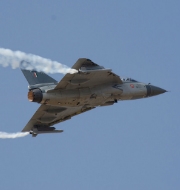Indian Air Force successfully carries first-ever mid-air refuelling of LCA Tejas
Indian Air Force (IAF) has successfully carried out first ever midair refuelling of indigenously developed light combat aircraft (LCA) Tejas. The midair refuelling test conducted involved dry linkup, meaning no fuel was actually transferred between IAF Il-78 tanker and Tejas fighter jet through its air-to-air refuelling probe.
Key Facts
For this test, Russian-built IL-78 MKI tanker was launched from IAF’s base in Agra while LCA Tejas fighter was launched from Gwalior. Nine more tests will be held which will also include wet tests where actual transfer of fuel takes place from IAF tanker to fighter jet. The success of these midair refuelling trials will be major leap for indigenous fighter which will help in enhancing its mission capability by increasing its range and payload. . The ability to carry out air-to-air refuelling is also one of critical requirements for LCA Tejas to achieve final operational clearance .
LCA Tejas
LCA Tejas is lightweight single-seat multi-role jet fighter, powered by single engine. It has tailess and compound delta wing design made entirely of composite structures. It is pegged as world’s smallest and lightest supersonic fighter aircraft in its class.
It is first advanced fly-by-wire Light Combat Aircraft (LCA) designed, developed and manufactured indigenously by state owned Hindustan Aeronautical Limited (HAL) and Aeronautical Development Agency (ADA) as part of LCA programme, started in 1980s to replace India’s ageing MiG-21 fighters. It was named ‘Tejas’, which means ‘radiance’, by former prime minister Atal Bihari Vajpayee. It took total of 20 years from 1993 to 2013 for building this aircraft. Its maiden flight took place in 2001.
Advance Features: LCA Tejas is equipped with quadruplex digital fly-by-wire flight control system to ease handling by the pilot. It also has digital computer-based attack system and autopilot mode. It is also equipped with satellite-aided Inertial Navigation System.
Stealth Features: It has many features of stealth fighter aircraft. Its radar cross section is very less compared to other aircrafts like MiG-29, F-16 due to its small size and extensive usage of carbon composits. It incorporates glass cockpit in which pilot is feed with real time information. It also has open architecture software for avionics which can be easily updated as and when required.
Range: It has limited reach of little over 400-km and will be mainly used for close air-to-ground operations (unlike Russian-origin Sukhoi-30MKIs or Rafale which have deep strike capability into enemy territory due to their long range).
Weaponry: It can fire air-to-air missiles, carry bombs and precision guided ammunition.DRDO has successfully tested fired Tejas with different kinds of weaponry and missiles including R-73 air-to-air missile, bomb dropping (including laser guided bombs). In future, DRDO also plans test firing of indigenous Astra missile and guns from the Tejas.
Operations: LCA Tejas had commenced operations from Sulur Air Force Station in Tamil Nadu in July 2018, two years after it was formally inducted into IAF. The fighter jet is part of ‘Flying Daggers’ of 45 Squadron of IAF. Southern Air Command based in Kerala capital Thiruvananthapuram has been entrusted with responsibility of integrating fighter aircraft in IAF’s concept of operations.
Month: Current Affairs - September, 2018


